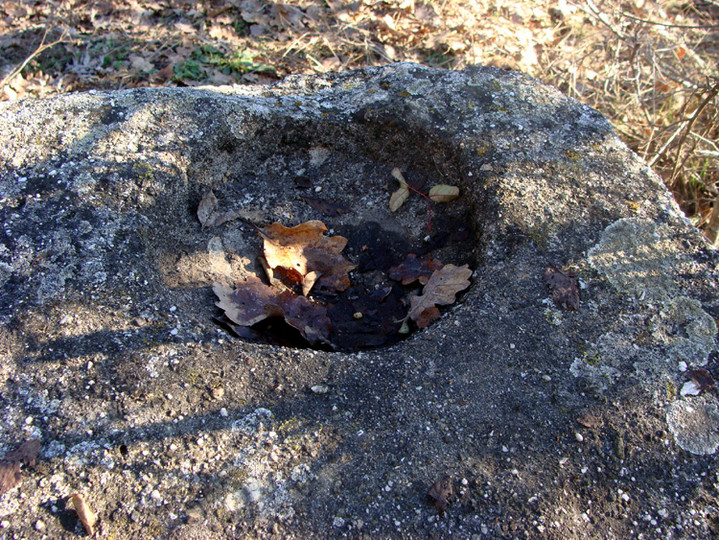
Italian version
Sant’alosio is a little village on the top af an high hill on the south/east of Piedmont. The rocks are partially covered by the eastern tower and also by lots of vegetation, but you can still see some cup marks expecially in winter without snow. Some cups looks very old and little, one is bigger (20 cm) and, I think, more recent. From this place you have a great 360° view, you can see all the western Alps, Ligurian Appennino and hills.

view of the site: the rocks under the towers.

again the big cup

the biggest cup

another cup

another cup mark, under the tower
The monolith during the centuries after christianization was used as stone to build an old church, as a pillory to punish insolvent debitors in medieval times, then when this area was part of France, moved in to the central square and in the last century as bench!

a cup mark

the menhir

the menhir
Chivasso’s menhir is one of 3 (Chivasso, Mazzè, Lugnacco) similar menhir survived trhough the centuries, part of bigger group in these area.
It’s 4 meters tall, it have a cup mark on it (and 2 holes made in medieval times) and now it’s conserved in a big glass box in a central square (piazza d’Armi) in Chivasso. The exact original position is not known.
Recently, the local historian Prof. Luciano Dell’Olmo recognized the importance of the piece and the town administration decided to restore it.
The name of this path (Sentiero Delle Anime – The Path of the Souls) comes from a local legend: the walk of the souls of the deads on this way from east to west, expecially in the night.
some of the most important rocks with pictures, drawings and infos.
This valley it’s full of engraved rocks, and every years new sites are found.
Some of the most important rocks (cup marks, anthropomorphic figures, crosses and strange tables) are situated along the so called “Way of the souls” path (Sentiero delle Anime) near the village of Traversella (Torino). From prehistoryc times untill the the last centuries local alpine culture is rapresented here on the rocks: cup marks, anthropomorphic figures are the most ancient engravings, most of the rocks were cristianised with crosses.
Another important site (not rapresented here) in this valley is the “Pera dij Cros” (it means “Rock of the crosses” in piedmonteis) where it is possible to notice many prehistoric anthropomorphic figures.

cup marks, crosses and anthropomorphic figures.

Unknown symbols, cup marks, crosses...

square cup, cup marks and some crosses.

Cup marks: one bigger (well visible) with 5 smaller cups and canals.
“La Pietra della vita” (The Stone of life) is a big natural stone, glacial erratic, in Oropa near Biella. The stone is still visible on the backside of the shrine and it was object of strong fertility cults in the ancient times. The cult survived untill the christian era but christianized with a lot of crosses engraved on it first, than with a chapel built on it.

2 of the several engraved crosses on the stone.

Another pic of the rock. On the left you can see the chapel built on it.


A map with pictures of the 2 group of menhirs in Cavaglià, by Luca Lenzi.


The rock where I found the engraving.




